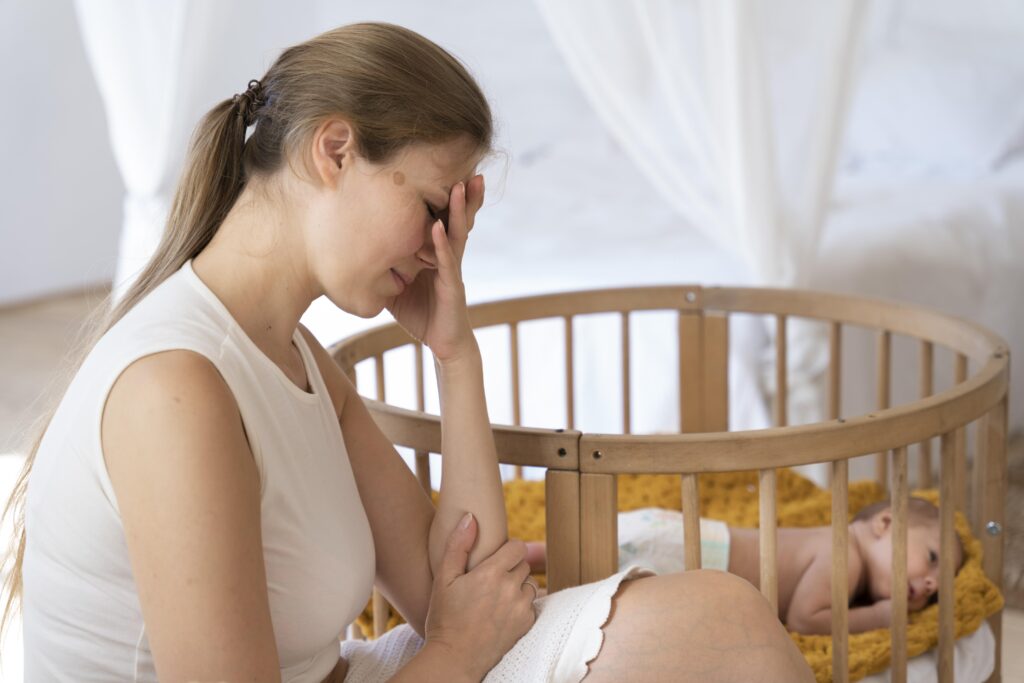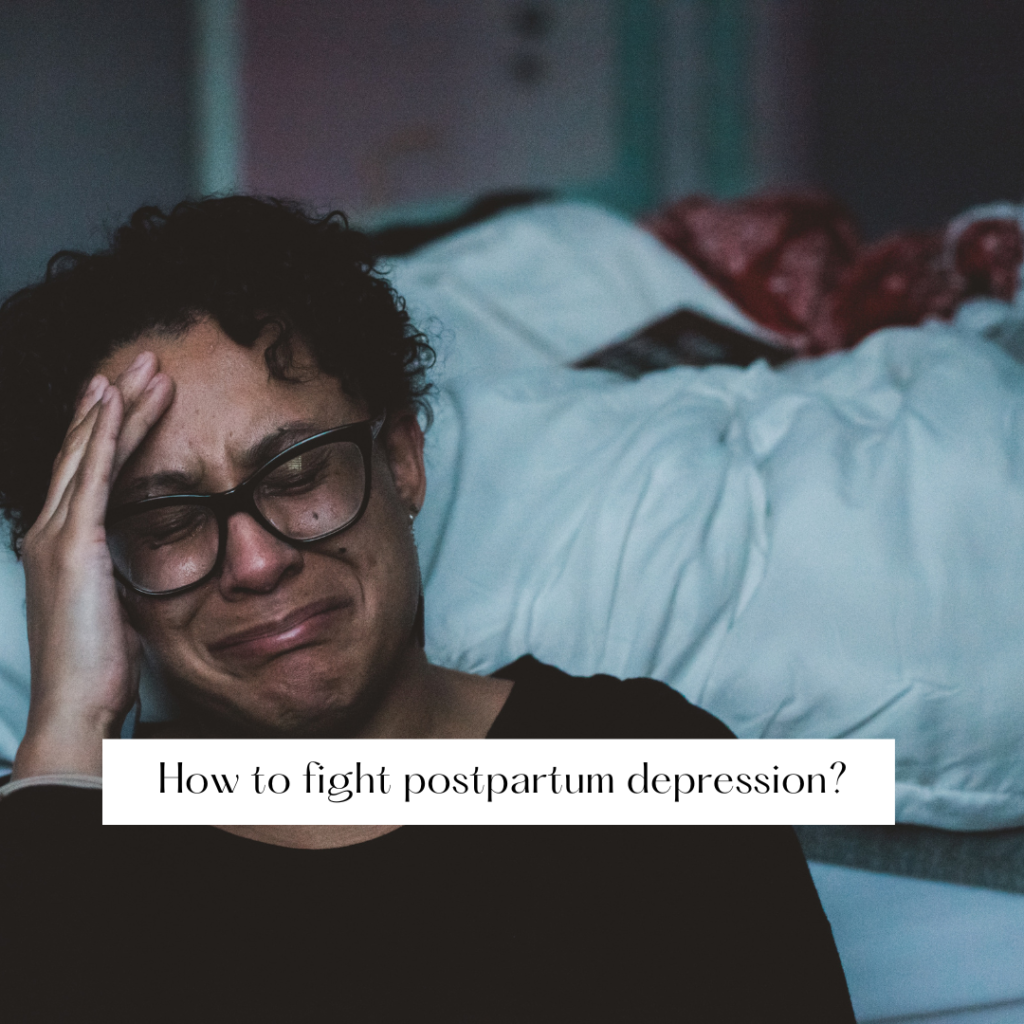Did you know close to 80% of new moms feel depressed. anxious or even angry after giving birth to their baby? Which means 4 out of 5 new mothers are at risk of getting anxiety disorder like depression or anxiety.
As per the stats, 1 in 7 women suffer from postpartum depression (PPD) after childbirth. A lot of the times anxiety and stress goes away with time but in some severe cases where the person is diagnosed with PPD, postpartum depression treatments are very crucial.

“Honestly, sometimes I still think I have to deal with postpartum depression. I think people need to talk about it more because it’s almost like the fourth trimester, it’s part of the pregnancy. I remember one day, I couldn’t find Olympia’s bottle and I got so upset I started crying… because I wanted to be perfect for her”
– Serena Williams in Harper’s Bazaar
Julie Lamppa, a Mayo Clinic certified nurse-midwife, explains that around 80% of new mothers go through a phase commonly referred to as the “baby blues” in the initial weeks following childbirth.
However, postpartum depression (PPD), which affects approximately 15% of new mothers, is more persistent and severe in nature, lasting longer than the baby blues.
What is Postpartum Depression
Postpartum depression (PPD), also known as postnatal depression, is a mood disorder that can affect some women after giving birth. It is characterized by a range of emotional and physical symptoms that can be severe and impact a woman’s ability to function and care for herself and her baby. PPD typically occurs within the first year following childbirth, with many cases emerging in the first few weeks or months.
Why does Postpartum Depression happen
The exact cause of postpartum depression (PPD) is not well understood and is likely the result of a complex interplay of physical, emotional, and lifestyle factors. Here are some key factors that contribute to the development of PPD:
Psychological Risk Factors
This generally happens if there is history of depression, PMS, sexual abuse of some form or reluctance towards baby or baby’s gender. These are the main developing factors under psychological factors. If you’ve had postpartum depression before, your risk increases to 30% each pregnancy.
Obstetric Risk Factors
These are mainly high risk pregnancies, for example preterm or low birth rate, hospitalizations because of something serious, emergency C-section.
Social Factors
Lack of social or family support can cause PPD in a major way.
Lifestyle Issues
Contributions of Lifestyle to Postpartum Depression – Lifestyle factors can play a role in the emergence or worsening of postpartum depression (PPD) for some individuals. It’s important to recognize that lifestyle factors are just one part of the larger picture. Not every woman facing lifestyle challenges during the postpartum period will experience PPD, and conversely, PPD can manifest even in the absence of significant lifestyle issues.
Baby Blues vs Postpartum Depression
Mayo Clinic family medicine specialist Dr. Summer Allen says that postpartum depression is different than the baby blues, which typically lasts about two weeks.
Baby Blues and Postpartum Depression (PPD) represent separate conditions that may influence new mothers during the postpartum period. While they exhibit certain similarities, their distinctions become apparent when considering factors such as severity, duration, and overall impact.
Baby Blues
- Onset: Baby blues typically occur in the first few days after childbirth and usually subside within a few weeks.
- Symptoms: Common symptoms include mood swings, irritability, tearfulness, mild anxiety, and feelings of being overwhelmed. These feelings are often described as being mild to moderate in intensity.
- Duration: Baby blues are usually short-lived, lasting for a few days to a few weeks.
- Cause: The exact cause of baby blues is not well understood but is thought to be related to the rapid hormonal changes that occur after childbirth, combined with the stress and adjustment of becoming a new parent.
- Impact: While baby blues can be emotionally distressing, they are considered a normal and common reaction to the challenges of new motherhood. They do not typically interfere with a mother’s ability to care for her baby.
Postpartum Depression (PPD)
- Onset: PPD can develop within the first year after childbirth, with many cases emerging within the first few weeks or months.
- Symptoms: PPD involves more severe and persistent symptoms, including persistent sadness, hopelessness, loss of interest in daily activities, severe mood swings, excessive fatigue, anxiety, and feelings of guilt or worthlessness. It may also lead to physical symptoms like changes in appetite and sleep disturbances.
- Duration: PPD symptoms are long-lasting and can persist for several months or even longer if left untreated.
- Cause: PPD is a complex condition influenced by hormonal changes, genetic factors, psychological factors, and lifestyle issues. It is not a normal or expected part of the postpartum period.
- Impact: PPD can significantly impact a woman’s ability to care for herself and her baby. It can interfere with her daily functioning, relationships, and overall quality of life.
It’s important to distinguish between baby blues and postpartum depression because the treatment and approach to these conditions differ. Baby blues often resolve on their own without medical intervention, while PPD requires appropriate diagnosis and treatment, which may include therapy, support groups, and, in some cases, medication.
Postpartum Psychosis
Postpartum psychosis is a relatively rare yet grave mental health condition that can manifest in some women shortly after giving birth. This condition represents an extreme form of postpartum mood disorders and is regarded as a psychiatric emergency due to the potential for severe symptoms and associated risks.
Symptoms of Postpartum Psychosis
- Delusions: Postpartum psychosis is frequently characterized by delusions, which are firmly held false beliefs that lack any basis in reality. These delusions often center around themes related to the baby’s safety, identity, or other irrational convictions.
- Hallucinations: Women who experience postpartum psychosis may encounter hallucinations, including auditory hallucinations (hearing voices), visual hallucinations (seeing things), or sensory experiences that others do not perceive.
- Mood Fluctuations: While individuals with postpartum psychosis may have periods of intense excitement or elation, these are often followed by abrupt shifts into severe depression or agitation.
- Confusion and Disorientation: Those affected by postpartum psychosis may struggle with disorientation and difficulty in maintaining clear and logical thinking.
- Rapid Onset: Postpartum psychosis usually emerges within the first two weeks after childbirth, although it can also appear as late as the first few months postpartum
Risk Factors
The precise cause of postpartum psychosis remains a subject of ongoing research. However, there are several risk factors that may contribute to its development, including a personal or family history of bipolar disorder or prior instances of postpartum psychosis. The swift hormonal changes that occur after childbirth are also thought to play a role in its onset.
Postpartum Depression Treatments

There are different postpartum depression treatments depending on the diagnosis that is done. Let’s dive into the options available depending on the seriousness of the diagnosis.
Psychotherapy
Seeking guidance from a psychiatrist, psychologist, or another mental health expert can prove beneficial. Therapy offers a platform to discuss your worries, learn effective coping strategies, address problems, establish achievable objectives, and react positively to situations. Family or couples therapy may also be advantageous. Therapeutic approaches for postpartum depression encompass cognitive-behavioral therapy (CBT) and interpersonal psychotherapy, among others
Antidepressants
Your doctor might suggest an antidepressant as part of your treatment. If you are breastfeeding, it’s important to note that any medication you take may pass into your breast milk. Fortunately, the majority of antidepressants can be safely used during breastfeeding, typically posing minimal risk of side effects for your baby. Collaborate with your healthcare provider to carefully evaluate the potential advantages and drawbacks of particular antidepressants.
Other Medicines
Additional medications can be incorporated into your treatment plan as necessary. For instance, if your postpartum depression is accompanied by pronounced anxiety or sleep disturbances, your healthcare provider may suggest a short-term prescription for an antianxiety medication.
Specially For Stay At Home Moms

Stay at home moms might also have early postpartum depression symptoms which if identified early can be worked on.
Staying at home as a mom can be a rewarding and fulfilling experience, but it can also be challenging and at times lead to feelings of isolation or depression.
Understand that you can’t do it all, and that’s okay. Set realistic expectations for yourself and your daily tasks. Don’t strive for perfection; aim for balance instead.
Connect with other moms in your community or online. Join local parenting groups, attend playdates, or engage with mom forums and social media groups. Sharing experiences with other moms can reduce feelings of isolation.
Make self-care a priority. Find time for activities you enjoy, even if it’s just for a short period each day. Read a book, take a bath, practice a hobby, or simply relax.
Physical activity is not only beneficial for your health but also your mood. Even a short daily walk can make a difference in how you feel.
Schedule regular “me-time.” Whether it’s a solo outing or time alone at home, having moments to yourself can be rejuvenating.
There are other topics I have already covered around postpartum which you might be interested in:
Easy Guide To Postpartum Recovery For New Moms
10 Effective Home Remedies For Hair Fall After Pregnancy
10 Life-Changing Permanent Body Changes After Pregnancy
Frequently Asked Questions
How to help wife with postpartum depression?
Supporting your wife through postpartum depression (PPD) requires patience, understanding, and a commitment to her well-being. First and foremost, encourage open communication and actively listen to her feelings without judgment.
Educate yourself about PPD to better comprehend what she’s going through. Offer emotional support, reassuring her that you love her and you’re in this together. Help with daily tasks, as PPD often leads to overwhelming fatigue and a lack of motivation.
How to avoid postpartum depression?
While postpartum depression cannot always be entirely prevented, there are steps you can take to reduce the risk and promote emotional well-being after childbirth. Building a strong support system is vital; ensure you have friends, family, and your partner available to help with baby care and provide emotional support.
Prioritize self-care, including rest, healthy eating, and exercise when possible. Educate yourself about postpartum depression and its symptoms so you can recognize them early.
What can I do at home for postpartum?
In the postpartum period, there are various essential steps you can take within the comfort of your home to enhance your physical and emotional well-being. It is vital to prioritize adequate rest and sleep, aligning your naps with your baby’s sleep schedule and seeking assistance from your partner or support network for nighttime feedings.
Ensure you maintain a well-balanced diet with a particular focus on nutritious foods, and stay well-hydrated with ample water intake. You can gradually introduce gentle postpartum exercises to rebuild your strength and boost your mood, always consulting your healthcare provider before starting any exercise routine.
How long does postpartum depression last?
The duration of postpartum depression (PPD) can vary from person to person. Some women experience relatively short episodes of PPD, while others may face more prolonged challenges.
